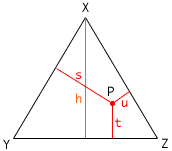Hi. My name is Sarah. I'm a secondary student taking a Math 30C course by correspondence. The question has two parts.
The first part is:
Thank you.
Sincerely, Sarah
Hi Sarah,
The instructions are to accurately draw an equilateral triangle XYZ, construct the altitude from X, choose a point P in the triangle and construct the perpendiculars as requested. This give a diagram resembling what is below.

Then you are to use a ruler, measure the lengths h, s, t and u, and look for a relationship among these measurements.
The instructions seem to be saying that the relationship you arre looking for does not depend on the placemeny of P as long as it is inside or on the triangle. This makes me think to try some special choices for P first before making the measurements.
- What happens if P is X?
- What happens if P is Z?
- What happens if P is the midpoint of the altitude through X?
- What happens if P is the midpoint of XZ?
Drawing a diagram in each case shows that
- If P is X then s = 0, u = 0 and t = h.
- If P is Z then u = 0, t = 0 and s is the length of an altitude of the triangle. Since the triangle is equilateral all three altitudes are of the same length so s = h.
- If P is the midpoint of the altitude through X then t = h/2. What can you show about u and s?
- What happens if P is the midpoint of XZ?
Can you now quess the relationship among h, s, t and u? Now go back to the diagram you drew, measure h, s, t and u. Is the relationship valid in this case also?
Penny